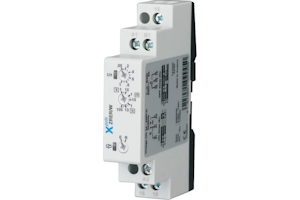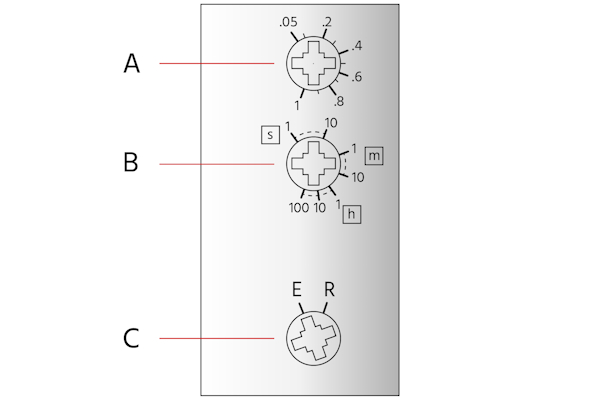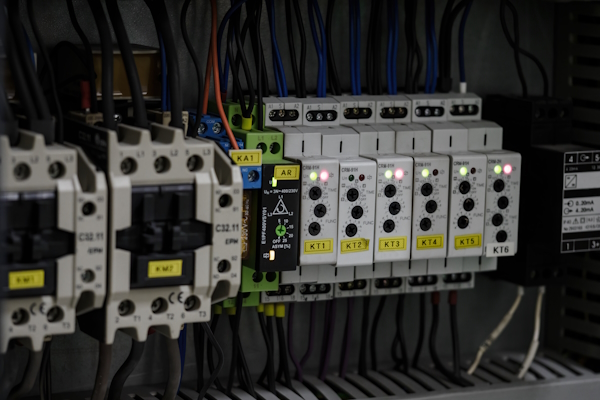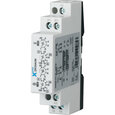How Does a Time Delay Relay Work?

Figure 1: An Eaton timing relay
Time delay relays provide precise control over the timing of operations, ensuring that devices and circuits function in a coordinated manner. They are commonly found in industrial automation and HVAC systems where precise timing control is important. This article will explain what time delay relays are, their working principles, types, applications, practical examples, wiring diagrams, and symbols.
Table of contents
- What is a time delay relay?
- Working principle
- How to read a timer delay relay
- Types of timing relays
- Applications of time delay relays
- Practical examples and wiring
- FAQs
View our online selection of time delay relays!
What is a time delay relay?
A time delay relay is an electromechanical or electronic device that controls the opening or closing of contacts after a predetermined time interval. Unlike standard relays that switch immediately upon receiving an input signal, time delay relays introduce a delay period before the switching action occurs. This delay can be configured to suit specific application requirements, ranging from milliseconds to several hours. Time delay relays are used to manage the timing of operations in various systems, ensuring that processes occur in a controlled and sequential manner. They are commonly found in industrial automation, HVAC systems, and other applications where precise timing control is crucial.
Working principle
Time delay relays operate based on a timing mechanism that controls the activation or deactivation of their contacts. This section covers the working principle of an on-delay time delay relay, which delays before a switch is made. See more about the differences between on and off-delay relays in the delay relay type section below. The working principle can be broken down into the following steps:
- Input signal: The relay receives an input signal, which can be electrical (voltage or current) or mechanical (manual switch).
- Timing mechanism activation: Upon receiving the input signal, the timing mechanism within the relay is activated. This mechanism can be electronic (using capacitors, resistors, and microcontrollers) or electromechanical (using a clockwork mechanism or motor).
- Delay period: The timing mechanism counts down the preset delay period. During this time, the relay remains in its initial state (either normally open or normally closed). If the input signal is interrupted or removed before the countdown completes, the relay may reset and not switch states as intended.
- Contact switching: Once the delay period elapses, the relay's contacts change state. For a normally open relay, the contacts close, allowing current to flow. For a normally closed relay, the contacts open, interrupting the current flow.
- Maintaining state: The relay maintains its new state until the input signal is removed or another condition is met (such as a reset signal).
- Resetting: Some time delay relays have a reset function that allows the timing mechanism to be reset before the delay period completes, returning the relay to its initial state.
The precise control over the delay period is achieved through adjustable components such as potentiometers, digital settings, or programmable logic. This flexibility allows time delay relays to be tailored to a wide range of applications.
How to read a timer delay relay
A timer delay relay can have multiple labeled dials that allows a user to program the relay's operation. This section uses the Eaton Timing Relay ZRER/W as an example to explain how to read and use the different dials.
As seen in Figure 2, this timing relay has three dials:
- Dial 1 (A): Dial 1 is a relay timer and provides more precise control over the delay by determining the fraction of Dial 2. For example, if Dial 1 is set to .6, the delay will be 60% of the value Dial 2 is set to.
- Dial 2 (B): Dial 2 allows a user to set the delay between 1 and 10 seconds, 1 and 10 minutes, or 1 and 100 hours.
- Dial 3 (C): Dial 3 allows the user to select whether the relay will delay turning on (E) or off (R).

Figure 2: A timing relay with 3 dials. Dial 1 (A) controls the fraction of Dial 2 (B) which can be set to seconds, minutes, or hours. Dial 3 (C) controls whether the delay is for the relay to turn on (E) or off (R).
Types of timing relays
Timing relays are essential components in various control systems, designed to meet specific timing and control requirements. They can be broadly categorized into single-function and multi-function relays.
Single-function timing relays
- On-delay relays: Delays activation of contacts after receiving an input signal, used for actions like starting a motor after power-up.
- Off-delay relays: Contacts switch state immediately upon receiving an input signal and return to the original state after a delay, used for actions like keeping a fan running after a machine is turned off.
- Single-shot (one-shot) relays: Activates contacts for a single, fixed duration upon receiving an input signal, ideal for triggering alarms or initiating processes.
- Repeat cycle relays: Alternates between on and off states continuously based on preset intervals, perfect for periodic cycling like flashing lights or intermittent pump operation.
- Interval relays: Contacts switch state immediately upon receiving an input signal and remain in that state for a preset duration, used for timed operations like controlling a heating element.
Multi-function timing relays
Multi-function relays combine multiple timing functions, from the list of single-function timing relays seen above, into a single unit, offering flexibility for complex applications like industrial automation systems.
Applications of time delay relays
Time delay relays are versatile components used in various applications across different industries. Some common applications include:
- Industrial automation: Time delay relays control the sequential start and stop of conveyor belts for smooth material handling and manage the timing of machine operations, including starting motors, activating solenoids, and controlling actuators.
- HVAC systems: Time delay relays prevent short cycling of compressors by introducing a delay between successive starts and control the delay in starting or stopping fans to ensure proper ventilation and temperature control.
- Lighting control: Time delay relays ensure that lights remain on for a set period after being activated, providing sufficient illumination for safe passage, and control the duration of emergency lights in case of power failure, ensuring safety and compliance with regulations.
- Automotive applications: Time delay relays manage the intermittent operation of windshield wipers, improving visibility during light rain, and control the duration of rear window defoggers, ensuring clear visibility without excessive power consumption.
- Security systems: Time delay relays provide a delay before triggering alarms, allowing authorized personnel to disarm the system, and control the timing of door locks and entry systems, ensuring secure and controlled access.
- Home appliances: Time delay relays manage the timing of different washing cycles in washing machines, ensuring efficient operation, and control the duration of cooking and defrosting cycles in microwave ovens, providing precise timing for various functions.
- Power management: Time delay relays control the sequential disconnection and reconnection of loads to prevent overloading and ensure stable power distribution, and manage the timing of generator start and stop sequences, ensuring reliable power backup.
- Process control: Time delay relays control the timing of chemical reactions and mixing processes in chemical processing, ensuring consistent product quality, and manage the timing of pumps, valves, and other equipment in water treatment plants, ensuring efficient operation.
- Switchboards: Time delay relays are used in switchboards to manage the timing of circuit breaker operations, ensuring safe and controlled power distribution. They can introduce delays to prevent simultaneous switching of multiple circuits, reducing the risk of electrical faults and enhancing system reliability.

Figure 3: Time delay relays used in a switchboard
Practical examples and wiring
Time delay relays are often used in practical applications where precise timing control is essential. Below are a few examples along with corresponding wiring diagram for time delay relay explanations:
Table 1: Time delay relay practical examples and wiring
| Example | Description | Wiring |
|---|---|---|
| Example 1 | A time delay relay is used to delay the start of a motor by 10 seconds after the power is applied. | Power supply (+) to time delay relay (input) Time delay relay (output) to motor Power Supply (-) to motor |
| Example 2 | A time delay relay is used to keep the staircase light on for 2 minutes after the switch is pressed. | Power Supply (+) to switch to time delay relay (input) Time delay relay (output) to light Power supply (-) to light |
| Example 3 | A time delay relay is used to prevent short cycling of a compressor by introducing a 5-minute delay between successive starts. | Thermostat to time delay relay (input) Time delay relay (output) to compressor |
| Example 4 | A time delay relay is used to control the intermittent operation of windshield wipers with a delay of 3 seconds between wipes. | Wiper switch to time delay relay (input) Time delay relay (output) to wiper motor |
| Example 5 | A time delay relay is used to control the duration of emergency lighting, keeping the lights on for 30 minutes after a power failure. | Power supply (+) to time delay relay (input) Time delay relay (output) to emergency light Power supply (-) to emergency light |
FAQs
What is the difference between an on-delay and an off-delay relay?
An on-delay relay activates contacts after a delay when the signal is received. An off-delay relay changes contacts with the signal and returns after a preset delay once the signal is removed.
Can time delay relays be used in both AC and DC circuits?
Yes, time delay relays are available for both AC and DC circuits. It is essential to select a relay that matches the voltage and type (AC or DC) of the circuit in which it will be used.
How do you adjust the delay time on a time delay relay?
Adjust the delay time on a time delay relay using built-in controls like potentiometers, dip switches, or digital settings. Refer to the relay's datasheet or user manual for specific instructions.
Can a time delay relay be used to control multiple devices?
A time delay relay can control multiple devices if its contact ratings can handle the combined load. Ensure the relay's contact ratings (current and voltage) are not exceeded.
What is the purpose of a reset function in a time delay relay?
The reset function resets the relay's timing mechanism before the delay ends, returning it to its initial state. This is useful for interrupting and restarting the timing sequence in applications.





